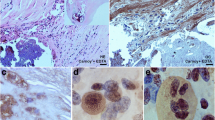Abstract
Immunohistochemistry for specific proteins characteristic of proliferative or apoptotic cells allows for monitoring of these cell behaviors in biological tissues samples, including atherosclerotic plaques and intimal thickenings. Proliferating cell nuclear antigen (PCNA) and Ki-67 are widely used markers of cell proliferation and cleaved caspase-3 is a well-established marker of apoptosis that can be detected in tissue samples using immunohistochemistry. This technique enables quantification of the abundance of these proteins and provides information on the distribution of these biomarkers in tissues. By combining with immunohistochemistry for specific cell type markers, it is also possible to determine which cell types are proliferating or undergoing apoptosis. Here, we detail protocols for immunohistochemistry of PCNA, Ki-67, and cleaved caspase-3 for evaluation of cellular proliferation and apoptosis in atherosclerotic plaques in vivo. In addition, we outline methods for the quantification and localization of cell proliferation using bromodeoxyuridine/5-bromo-2′-deoxyuridine (BrdU) and ethynyldeoxyuridine/5-ethynyl-2 ́-deoxyuridine(EdU) labeled tissue samples collected from animals exposed to BrdU or EdU.
Access this chapter
Tax calculation will be finalised at checkout
Purchases are for personal use only
Similar content being viewed by others
References
Ehmann UK, Williams JR, Nagle WA, Brown JA, Belli JA, Lett JT (1975) Perturbations in cell cycle progression from radioactive DNA precursors. Nature 258(5536):633–636. https://doi.org/10.1038/258633a0
Kolb B, Pedersen B, Ballermann M, Gibb R, Whishaw IQ (1999) Embryonic and postnatal injections of bromodeoxyuridine produce age-dependent morphological and behavioral abnormalities. J Neurosci 19(6):2337–2346. https://doi.org/10.1523/jneurosci.19-06-02337.1999
Sekerková G, Ilijic E, Mugnaini E (2004) Bromodeoxyuridine administered during neurogenesis of the projection neurons causes cerebellar defects in rat. J Comp Neurol 470(3):221–239. https://doi.org/10.1002/cne.11016
Kuwagata M, Ogawa T, Nagata T, Shioda S (2007) The evaluation of early embryonic neurogenesis after exposure to the genotoxic agent 5-bromo-2′-deoxyuridine in mice. Neurotoxicology 28(4):780–789. https://doi.org/10.1016/j.neuro.2006.07.017
Duque A, Rakic P (2011) Different effects of bromodeoxyuridine and [3H]thymidine incorporation into DNA on cell proliferation, position, and fate. J Neurosci 31(42):15205–15217. https://doi.org/10.1523/jneurosci.3092-11.2011
Salic A, Mitchison TJ (2008) A chemical method for fast and sensitive detection of DNA synthesis in vivo. Proc Natl Acad Sci U S A 105(7):2415–2420. https://doi.org/10.1073/pnas.0712168105
Breinbauer R, Köhn M (2003) Azide-alkyne coupling: a powerful reaction for bioconjugate chemistry. Chembiochem 4(11):1147–1149. https://doi.org/10.1002/cbic.200300705
Wang Q, Chan TR, Hilgraf R, Fokin VV, Sharpless KB, Finn MG (2003) Bioconjugation by copper(I)-catalyzed azide-alkyne [3 + 2] cycloaddition. J Am Chem Soc 125(11):3192–3193. https://doi.org/10.1021/ja021381e
Rostovtsev VV, Green LG, Fokin VV, Sharpless KB (2002) A stepwise huisgen cycloaddition process: copper(I)-catalyzed regioselective "ligation" of azides and terminal alkynes. Angew Chem Int Ed Engl 41(14):2596–2599. https://doi.org/10.1002/1521-3773(20020715)41:14<2596::Aid-anie2596>3.0.Co;2-4
Kolb HC, Finn MG, Sharpless KB (2001) Click chemistry: diverse chemical function from a few good reactions. Angew Chem Int Ed Engl 40(11):2004–2021. https://doi.org/10.1002/1521-3773(20010601)40:11<2004::aid-anie2004>3.3.co;2-x
Kong XP, Onrust R, O'Donnell M, Kuriyan J (1992) Three-dimensional structure of the beta subunit of E. coli DNA polymerase III holoenzyme: a sliding DNA clamp. Cell 69(3):425–437. https://doi.org/10.1016/0092-8674(92)90445-i
Strzalka W, Ziemienowicz A (2011) Proliferating cell nuclear antigen (PCNA): a key factor in DNA replication and cell cycle regulation. Ann Bot 107(7):1127–1140. https://doi.org/10.1093/aob/mcq243
Mighell A (1995) PCNA and p53. Eur J Cancer B Oral Oncol 31b(6):403–404. https://doi.org/10.1016/0964-1955(95)00037-2
Maga G, Hubscher U (2003) Proliferating cell nuclear antigen (PCNA): a dancer with many partners. J Cell Sci 116(Pt 15):3051–3060. https://doi.org/10.1242/jcs.00653
Bologna-Molina R, Mosqueda-Taylor A, Molina-Frechero N, Mori-Estevez AD, Sánchez-Acuña G (2013) Comparison of the value of PCNA and Ki-67 as markers of cell proliferation in ameloblastic tumors. Med Oral Patol Oral Cir Bucal 18(2):e174–e179. https://doi.org/10.4317/medoral.18573
Bressenot A, Marchal S, Bezdetnaya L, Garrier J, Guillemin F, Plénat F (2009) Assessment of apoptosis by immunohistochemistry to active caspase-3, active caspase-7, or cleaved PARP in monolayer cells and spheroid and subcutaneous xenografts of human carcinoma. J Histochem Cytochem 57(4):289–300. https://doi.org/10.1369/jhc.2008.952044
Gown AM, Willingham MC (2002) Improved detection of apoptotic cells in archival paraffin sections: immunohistochemistry using antibodies to cleaved caspase 3. J Histochem Cytochem 50(4):449–454. https://doi.org/10.1177/002215540205000401
Jin Z, El-Deiry WS (2005) Overview of cell death signaling pathways. Cancer Biol Ther 4(2):139–163. https://doi.org/10.4161/cbt.4.2.1508
Acknowledgments
Jason Johnson is funded by British Heart Foundation Senior Research Fellowship, FS/18/1/33234.
Author information
Authors and Affiliations
Corresponding author
Editor information
Editors and Affiliations
Rights and permissions
Copyright information
© 2022 The Author(s), under exclusive license to Springer Science+Business Media, LLC, part of Springer Nature
About this protocol
Cite this protocol
Wadey, K.S., Johnson, J.L., George, S.J. (2022). Monitoring Cellular Proliferation and Apoptosis in Atherosclerosis Plaques and Intimal Thickenings. In: Ramji, D. (eds) Atherosclerosis. Methods in Molecular Biology, vol 2419. Humana, New York, NY. https://doi.org/10.1007/978-1-0716-1924-7_31
Download citation
DOI: https://doi.org/10.1007/978-1-0716-1924-7_31
Published:
Publisher Name: Humana, New York, NY
Print ISBN: 978-1-0716-1923-0
Online ISBN: 978-1-0716-1924-7
eBook Packages: Springer Protocols



